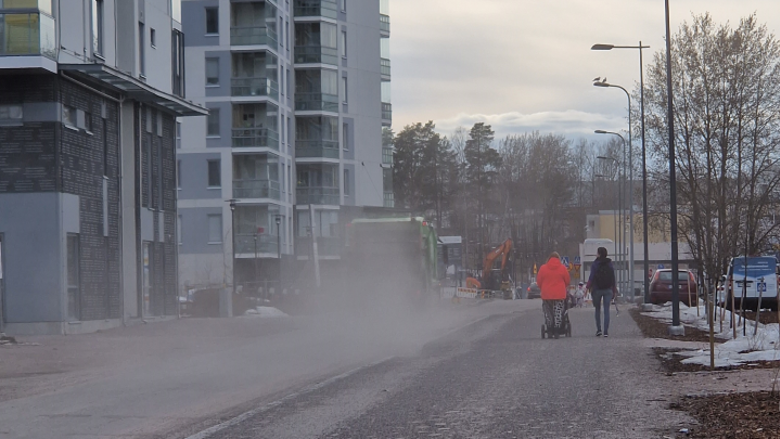Snow-free and dry streets are now dusty in the metropolitan area

Street dust deteriorates air quality across the metropolitan area. High concentrations of street dust are found in busy street and road environments. Street dust is particularly harmful to asthmatics and heart patients, but it can cause irritation symptoms to anyone, including healthy adults. HSY provides ten tips to alleviate the street dust problem.
There is now a lot of street dust in the air
Helsinki Region Environmental Services HSY monitors air quality and street dust situation across the metropolitan area. In recent days, traffic has raised street dust into the air from snowless, dry streets and roads.
- According to our measurements, there is now street dust in the air in the metropolitan area. Air quality has occasionally been poor in recent days, especially along busy main roads and streets, says HSY’s Senior Specialist in Air Quality Jarkko Niemi.
The weather is expected to remain mostly dry and clear. Dustiness in the coming days and weeks will vary according to the weather. On sunny and dry days, there is a lot of street dust in the air. Rain and snow, on the other hand, moisten the road surfaces, which reduces dustiness.
Dust is most prevalent in areas with heavy traffic
Street dust mainly consists of finely ground asphalt and sanding gravel. Studded tires, in particular, wear down the asphalt and thus produce street dust.
- Dust is most prevalent in areas with heavy traffic. However, you do not need to avoid outdoor activities because of street dust. Already one block away from a busy street, the air is cleaner, says Niemi.
- Street dust is not only a problem in large cities, but high particle concentrations can also occur in small municipalities and towns, Niemi continues.
Those responsible for the maintenance of streets and roads combat street dust taking into account the weather conditions. Spring cleaning of streets removes street dust from road surfaces. Dusting is also controlled by watering streets and road edges with a mild salt solution during the worst dust days.
Asthmatics, small children, as well as the elderly and people with respiratory and heart diseases are particularly sensitive to the health effects of dust. Street dust can worsen the symptoms of heart and respiratory patients. Street dust also causes irritation symptoms in healthy people, such as runny nose, cough, and itching of the eyes and throat.
10 tips for the street dust season
Niemi gives ten tips on how to prevent the formation of street dust or reduce the inhalation of street dust:
- Avoid unnecessary driving. Prefer walking, cycling, and public transport.
- If you drive, use friction tires as winter tires. They produce less dust than studded tires.
- Remember to follow vehicle relocation signs. Cleaning the streets slows down significantly if wrongly parked cars have to be moved.
- Avoid busy areas on dusty days if you can. A respirator can also help, but it is not suitable for everyone.
- Exercise further away from busy places – already one block away from a busy street, the air is cleaner.
- Keep windows closed during dusty times. Take care of the seals on windows and doors.
- Dry laundry indoors.
- Get efficient air intake filters for your home and keep them in good condition. Change filters in spring and autumn.
- Remove sanding gravel while it is wet. The use of leaf blowers for removing sanding gravel is prohibited in the metropolitan area and many other cities.
- Follow the air quality situation at hsy.fi/en/airquality.
HSY measures street dust concentrations at twenty different measurement points in the metropolitan area. You can follow the amount of street dust in real-time at hsy.fi/en/streetdust.
More information:
- Air quality right now in the metropolitan area: fi/en/airquality
- Air quality elsewhere in Uusimaa: Air quality Uusimaa - HSY
- Information about street dust and its concentrations: fi/en/streetdust
- How to alleviate your symptoms: Help for street dust symptoms -brochure (pdf) in English pdf